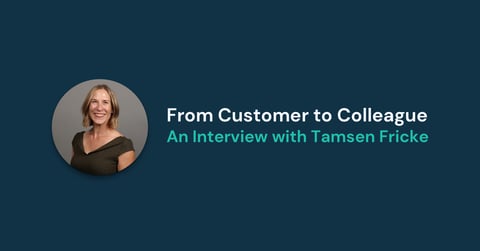Why I Chose Shipium: An Interview with Tamsen Fricke, Carrier Operations Program Manager

Founded in 2019, Shipium has had a lot of “firsts” but one of the more fun recent occasions was when Tamsen Fricke joined Shipium’s transportation ops team. Tamsen is the first former customer and direct user of Shipium to change seats and actually work for Shipium.
With a unique perspective as a former customer, we interviewed Tamsen to share more about her background, what led her to logistics as a career path, and how she views Shipium as a solution in her peer community.
Hi Tamsen! Your career background is really interesting. Could you share more on your journey through the world of logistics.
I started my career in transportation while living in Ecuador exporting summer flowers to the US and Europe. My role was brokering sales and transportation for a cooperative of Ecuadorian flower farms, which was no small feat given the difficulty of forwarding perishable freight as the world changed post-9/11. This taught me the importance of speed and delivery accuracy in a customer-centric supply chain.
From there I grew into managing government logistics programs in Washington D.C., mostly for the Department of Defense (DoD) and Defense Logistics Agency (DLA). This is where more direct relationships with carriers started to become my day-to-day. While it wasn’t shipping flowers from Ecuador which has its own level of complexity, it was enormously complex given the breadth and diversity of the United States government. This taught me the importance of tools (mostly software) to manage the complexity and ever-changing nature of shipping operations. It’s almost impossible to manage volatility, costs, and constraints without the right technology.
That led me to more consumer-focused companies as an operations manager at Divine Chocolate, and a transportation analyst at Starbucks, and Arrow Electronics. The lesson learned during this period was how different yet similar transportation and logistics can be for brands (Divine), retailers (Starbucks), and B2B (Arrow). Regardless of what you’re shipping, every business has the same challenges of managing rising costs, managing carrier performance, and delivering on customer promises.
Then in 2021, I joined Grove Collaborative, which is where I encountered Shipium. As an industry veteran at this point, I was completely blown away at how Shipium was helping Grove with the challenges I saw throughout my career.
After a brief stint in the real estate side of commercial operations, I realized transportation is where I love to be. In a random act of comets aligning, an opening popped up to help manage carriers internally to the Shipium platform, and I knew this was an opportunity too good to pass up after seeing the value it brought my team at Grove.
What were the biggest benefits you saw with Shipium while at Grove?
Transportation teams experience so many daily challenges. I often feel like my peers don’t get enough recognition for the can-do attitude we have to employ in order to get most work done.
The three biggest challenges I saw at Grove mirrored the challenges I saw in other companies, but I was looking at it from a more granular perspective as I shifted from freight to large scale small parcel shipping.
The first was carrier diversification from a strategic point of view. If you recall in 2021, COVID-19 was still at its peak, which actually meant that ecommerce growth for a desirable brand like Grove was off the charts. One of the biggest carrier challenges we had was capacity and reliability of the carriers we were using. We wanted to adjust our carrier mix, but were stuck with slow tech that made change difficult. We needed to on-board and off-board carriers more quickly and have intelligent ways to rate each parcel dynamically within our carrier network.
During this era, new carriers were coming up with innovative business models and we needed to manage the new opportunities against volume thresholds set by the national carriers. As a result, we were in a constantly difficult position to set up proper volume awards to hit contract minimums while also trying to optimize for cost and service and take advantage of the exciting changes in the transportation market.
That leads to the third biggest challenge which was visibility into carrier performance. As the transportation manager who owned all carrier strategy and needed to make rapid decisions, lack of visibility to granular levels was a killer.
When we switched to Shipium, all these challenges went away.
I am not a tech person, and most legacy shipping solutions I’ve used have a combination of required coding to make any changes and gnarly reports that needed a tech degree to decipher. Shipium’s console was very intuitive. I found that I could update rates, rules, and manage my network configurations across all origins without requiring any outside help. No IT required to tweak a volume limit??? Sign me up!
While it required some help with the Shipium team at the time, turning on and turning off a new carrier was as fast as advertised. We were in a spot where we could turn on a carrier in a day or two versus the months it took prior. Turning off was a literal 5 minute job I could do myself.
Over time, what blew me away the most was how the core carrier selection process just worked. I found the information in the system was consistently accurate, and the most cost effective cost decisions were being made.
What’s your role with Shipium now?
I’m in the unique spot that some of what I would do as an actual customer of Shipium as a transportation analyst is part of the platform, too, which I didn’t realize at first.
I work on Shipium’s in-house transportation ops team that takes on the responsibility of working with carriers on behalf of customers.
One of my primary jobs is to ensure that the carriers’ rates are reflected in our system. The platform’s approach to rate management is interesting. Customers input their contracts into their account, and it’s all modeled virtually. I help ensure that those rates were done properly and are consistent. But as any good transportation manager will know, surcharges can fluctuate and be a nightmare across carriers. Well, the Shipium platform also manages all global surcharges across every carrier we integrate with, and my job is to help ensure those are accurate. With weekly changes, that’s way more work than you would think, and is the type of platform-wide benefit we help give customers that goes unnoticed. They don’t have to worry about it.
There is also work on the technical side, as well. Our in-house team acts as a technical liaison with carrier integrations during initial setup, and with any on-going maintenance. It’s a burden we take off the shoulders of customers when a carrier is having technical problems, which happens more frequently than you would think.
Lastly, I develop relationships with carriers to maintain open lines of communication for problem-solving. One of the reasons carriers are consistently recommending Shipium to their customers as a shipping tech solution is because we care about solving problems that help both shippers and carriers. Everyone is happy when shipments are getting shipped.
Coming as a prior customer, what made you most want to work here?
I always admired the professionalism and ability to solve tough problems from the team at Shipium. As a transportation manager, our role in the operations team is to ensure things get delivered on time as cheaply as possible. I always felt like the product is solving an important problem for the transportation management community, which is “how can I manage multiple carriers, understand my rates, and think strategically with a self service tool?” Now that I’m on the other side and get to work with other customers all day, that belief is only reinforced!

Diagonal thinker who enjoys hard problems of any variety. Currently employee #5 and the first business hire at Shipium, a Seattle startup founded by Amazon and Zulily vets to help ecommerce companies modernize their supply chains. Previously was CMO at Datica where I helped healthcare developers use the cloud. Prior to that I came up through product and engineering roles. In total, 18 years of experience leading marketing, product, sales, design, operations, and engineering initiatives within cloud-based technology companies.


